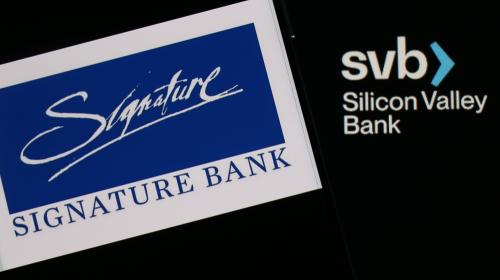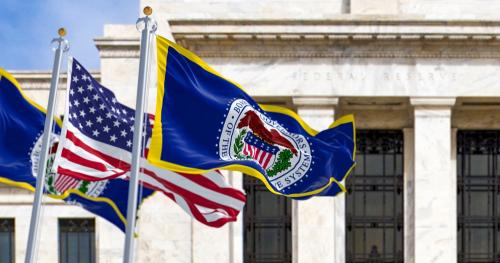The Federal Reserve’s discount window—through which it lends cash to liquidity-constrained solvent banks—is key to keeping credit flowing in the economy and avoiding financial crises when banks are under stress, but banks are often reluctant to use it, and those who do so find it frustratingly clunky. At a March 2024 Hutchins Center on Fiscal and Monetary Policy event, Susan McLaughlin, who oversaw lending to banks at the New York Federal Reserve Bank, offered several suggestions for fixing the discount window.
The discount window, which dates to the founding of the Fed in 1913, is meant to solve a fundamental challenge to banks. Banks make long-term loans to households and businesses (the bank’s assets), but fund those loans with deposits (the bank’s liabilities) that can be withdrawn suddenly. Even a bank with assets that are worth more than its liabilities can have trouble meeting depositors’ demands in a panic—a bank run—because a bank often can’t readily sell its loans for cash. In such cases, banks can borrow from the Fed’s discount window, posting those loans as collateral, so they can give depositors their money. Knowing that a bank has ready access to the discount window may be enough to reassure depositors that they don’t need to withdraw cash to protect themselves. Access to the discount window means that banks don’t have to sell loans or other assets at fire-sale prices to raise cash, which can trigger systemic financial instability. In addition, access to the discount window helps reduce the possibility that problems at one bank undermine confidence in other banks and lead to a run on their deposits.
There are two problems: One, there has for decades been a stigma that discourages banks from borrowing at the discount window, even when the Fed encourages it. Even the oft-used label “the lender of last resort” conveys desperation, William Demchak, CEO of PNC Financial Services Group, said. “The day you hit it for anything other than a test you effectively have told the world you failed.”
Two, the operations of the discount window are surprisingly old-fashioned. “You call your regional Fed, somebody answers the phone, maybe,” Demchak said. “Then they’ll have a meeting to see if it’s actually okay for you to draw, and they’ll talk to Washington and you draw. If I draw from the Federal Home Loan Bank, I hit a few keystrokes….”
The March 2023 turmoil in the banking system highlighted the shortcomings of the discount window’s current operations. Silicon Valley Bank and Signature Bank, both of which failed, weren’t prepared to borrow from the Fed. This has led to calls for every bank to pre-position collateral at the Fed and to test their arrangements so they can tap the window at a moment of stress.
McLaughlin, a 30-year veteran of the New York Fed and now affiliated with the Yale Program on Financial Stability, offered several suggestions to address problems with the discount window.
Reducing stigma
“We need in the U.S. to decide what we’re for with the discount window. Is it a facility that is a backstop that’s legitimate for sound banks to use against good collateral when they need it? Or is it something that really shouldn’t be used?” In the early years of the Federal Reserve, borrowing from the discount window was the Fed’s primary tool; the Fed didn’t, as it does now, buy and sell U.S. Treasury debt to influence short-term interest rates and provide liquidity to the system. In the 1920s, however, the Fed began discouraging banks from borrowing. “The constructive ambiguity doctrine—i.e., that the central bank should never pre-commit to lending to banks—which dates back to the 20s, has caused a lot of confusion. This idea is even embedded in the Federal Reserve Act—there’s a provision in Section 10(b) of the Federal Reserve Act (which governs discount window lending) that says that no Reserve Bank is obligated to provide a loan to a bank. I think that dates from the years leading into the Depression, when there were many bank failures and there was not yet robust prudential supervision of banks. At that time the Fed was very worried, legitimately, about lending to weak banks. But today, we have much more robust supervision.“ Supervisors today distinguish between sound and weak banks regularly in the supervisory ratings process, and Federal Reserve banks that extend loans also have credit analysis teams that look at additional indicators beyond supervisory ratings to assess and monitor borrower health.
“If banks are ready, but not willing to use the window, then the discount window can’t do its job in mitigating systemic risk. And importantly, stigma actually undermines the cause of bank readiness. So if I’m a bank and I know my management doesn’t really want me to use this, or I’m going to get criticized by my supervisors if I use it, I won’t want to use it, and I’m probably not going to be preparing to use it.”
Liquidity disconnect
McLaughlin pointed to a “disconnect also between current messaging from Fed officials, which is encouraging banks to use the discount window when they need it, and the way that discount window borrowing capacity is treated in our supervision of banks’ liquidity risk management.” In short, Fed officials say banks should be prepared to tap the discount window when they need to do so without reservation, but rules requiring banks to hold “high-quality liquid assets” to handle a sudden withdrawal of deposits, and internal liquidity stress testing and resolution funding plan requirements, generally don’t allow banks to count discount window borrowing capacity as a source of contingent liquidity. This doesn’t make sense. Liquidity regulations and central bank lending tools are not sufficiently integrated, and need to work together in the same direction to safeguard financial stability.
Improving infrastructure
The Fed can and should “improve its infrastructure and operational processes, to make the process of pledging collateral and borrowing from the window easier to access for banks. Borrowing from the window is actually a pretty manual process. A bank calls and there’s a period of time where the staff are checking to make sure that it’s okay to approve the loan. I think that for a sound bank, with sufficient eligible collateral to secure the loan, that waiting period almost seems to signal, ‘We don’t have to say yes.’ And I think that that’s… a legacy of this constructive ambiguity that started in the 20s. Why not automate the check for collateral for primary credit borrowers and make it more of a straight-through process?”
Primary vs. secondary credit
The Fed has had two categories of lending from the discount window since 2003. Primary credit is for banks that are in sound financial condition, and there aren’t any restrictions on how the bank uses the money. Secondary credit is for banks that aren’t healthy enough to qualify for primary credit and has more restrictions; the rate is higher than for primary credit and collateral haircuts are larger, a bank can’t use the money to expand its balance sheet, and loans are very short term. It’s basically a way for the Fed to keep a troubled bank afloat long enough for it to be sold or closed. McLaughlin suggested administering secondary credit separately to reduce the “muddying of the waters” that occurs when both healthy and weaker banks borrow at the discount window.
Review pricing of loans
Until 2003, the interest rate the Fed charged on discount window loans was lower than its key interest rate target, the federal funds rate (at which banks borrow from each other overnight). In 2003, the Fed decided to charge a higher rate, consistent with 19th century economist Walter Bagehot’s classic dictum that central banks should lend freely to solvent banks, but at a penalty rate. Since 2003, the primary credit rate has been priced at 100, 50, and 25 basis points over Fed funds at different times, and is currently priced at the Fed funds rate with no penalty. McLaughlin said the Fed should “revisit the appropriate pricing for primary credit to better balance the trade-off between creating stigma, if the rate is too high relative to market rates, and displacing market activity, if the rate is too low relative to other market rates.”
At the Hutchins Center event, Rep. Patrick McHenry (R-NC), chair of the House Financial Services Committee, harshly criticized banks for not being better prepared to use the discount window and the Fed for its old-fashioned operations. “They’re still using the phone?” he said. “You’re kidding me… Should be a push of a button rather than phone calls.”
The Fed has acknowledged the issues. In a February 2024 speech, Michael Barr, vice chair for (bank) supervision, said: “I remain focused on how we can improve bank readiness to tap the Fed’s discount window. The discount window provides ready access to liquidity, including when forms of market funding come under strain. But banks should do some preparation to be fully ready to tap the window. That includes pre-positioning collateral and testing discount window usage. While banks do their part to get operationally ready, we at the Federal Reserve also need to continue to improve discount window operations.”
For a video and transcript of the March 5 event, which was co-sponsored by the Center on Regulation and Markets, click here.
-
Acknowledgements and disclosures
The Brookings Institution is financed through the support of a diverse array of foundations, corporations, governments, individuals, as well as an endowment. A list of donors can be found in our annual reports published online here. The findings, interpretations, and conclusions in this report are solely those of its author(s) and are not influenced by any donation.
The Brookings Institution is committed to quality, independence, and impact.
We are supported by a diverse array of funders. In line with our values and policies, each Brookings publication represents the sole views of its author(s).




Commentary
How to fix what ails the Fed’s discount window
March 12, 2024